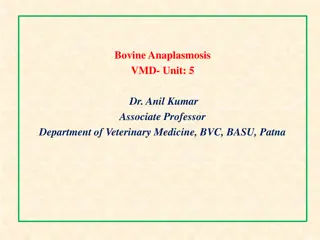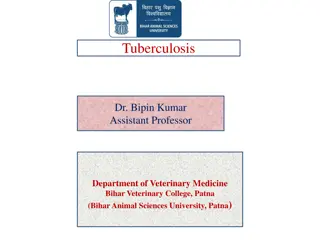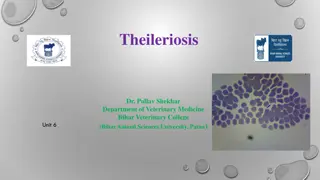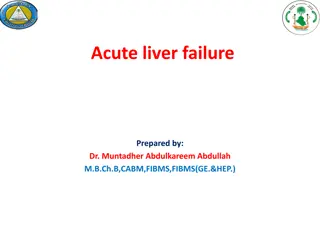Understanding Bovine Spongiform Encephalopathy (BSE) - The Mad Cow Disease
Subacute or chronic fatal neurodegenerative disease in adult cattle, Bovine Spongiform Encephalopathy (BSE) is a transmissible spongiform encephalopathy with spongy degeneration in the CNS. It is caused by an infectious protein called prion and is mostly found in Europe, with potential zoonotic impact leading to a variant of Creutzfeldt-Jakob disease. The disease has economic implications due to import/export restrictions and control costs.
Download Presentation

Please find below an Image/Link to download the presentation.
The content on the website is provided AS IS for your information and personal use only. It may not be sold, licensed, or shared on other websites without obtaining consent from the author. Download presentation by click this link. If you encounter any issues during the download, it is possible that the publisher has removed the file from their server.
E N D
Presentation Transcript
Bovine spongiform encephalopathy BSE Mad cow disease or Prion disease. By Dr/ Marawan Elfky
Definition Subacute or chronic fatal non-febrile sporadic neurodegenerative disease of adult cattle. Belongs to a group of diseases known as transmissible spongiform encephalopathies (TSEs). Ch. by a spongy degeneration in the CNS (brain and spinal cord) with neurological disorders signs.
Etiology Not been completely characterized Infectiousprotein, or scrapie-like infectious agent (prion) of very low M.wt. (non- detectable) around 35 KD (Classical or cBSE). Extremely resistant to heat and to normal sterilization processes. Sensitive to 4% sodium hydroxide, 2% chlorine and steam sterilization.
Epidemiology 1. Distribution: Mostly in Europe, with occasional cases been confirmed in Asia (Japan), the Middle East (Israel), and North America. 2. Host rang: (Cattle) Adult cattle at a peak age onset of 4-5 years . 30 times in dairy than beef cattle. Experimentally transmitted to pigs, sheep, goats, mice, and monkeys but birds are resist.
3. Seasonal incidence: No seasonal incidence. 4. Transmission: a. Source: Commercial feed (meat and bone meal) contaminated with the infectious agent. b. Mode: Ingestion of such meals. Vertical transmission may also occur. Not been transmitted via semen, milk, colostrum, urine, feces or hides.
5. Economic impact: losses due to: Importation and exportation restriction from infected localities and Cost of control and eradication. 6. Zoonotic impact: Zoonotic producing fatal variant Creutzfeldt Jakob disease vCJD (Vision problem, dysphagia, irritability, insomnia, loss of speech and muscle spam). To date, all known cases have been caused by the classical BSE prion Not H (1 2 kDa above) or L type BSE 0.5 kDa below CBSE .
Pathogenesis Not well understood or documented. It is suggested to be similar to scrapie in sheep in which after infection, replication of the agent start in the tonsils and retropharyngeal L. N then subsequently disseminated to others L. Ns and spleen, then by an unknown mechanism it reaches to the CNS. Replication occur with accumulation of disease associated abnormal protein (SAFs) in the nervous tissue and finally damage the cell (vacuoles in grey matter)
Clinical signs I.P is long (2- 8 y.) with low morbidity and 100% mortality; the course of the diseases varying from 1 to 6 months. Loss of muscle control resulting in abnormal gait, tremors, hind limb ataxia and poor balance. Behavioral changes may include aggression, anxiety, nervousness, frenzy, ataxia, abnormal facial expression or an overall change in temperament. Rarely but observed, persistent rubbing or licking.
Non-specific symptoms have also been observed which include weight loss, decreased milk production, lameness, ear infections and teeth grinding due to pain. Some animals may show a combination of these symptoms, while others not. Once clinical symptoms arise, they typically get worse over the upcoming weeks and months, eventually leading to recumbency, coma and death.
P/M lesions The pathognomonic lesion is bilateral symmetric non-inflammatory intra-cytoplasmic vacuolation of neuron and gray matter. Amyloid plaques that are associated with L-BSE prions not with the classical BSE prion or H-BSE. Scrapie-associated fibrils (SAF) in the affected neurons (electron microscope).
Diagnosis 1- Field diagnosis; depends on case history, clinical signs and P/M lesions. 2. Lab. Diagnosis; A. Sample: Mainly CNS including, brainstem, medulla oblongata and spinal cord. Some lymphoreticular tissues as spleen, thymus, tonsils and retropharyngeal L. N.
Diagnosis B. Laboratory procedures: (There is no live animal test for BSE) Histopathology of brain to detected microcavities. Detection of (SAF) by electron microscopy (excellent value to supply the routine histopathological diagnosis). Immunohistochemistry to detect the prion protein in the brain tissue.
Rapid test method using western blotting technique to detect and differentiate between the BSE. Sero-diagnosis of no practical mean as the infection by this agent does not provoke detectable antibodies. Experimental transmission Cattle: systemic or oral (sings after 48 months). Sheep: systemic or oral , signs appear as locomotor incoordination, trembling and difficult to move but there was no pruritis (if scrapie material +ve pruritis). Mice bioassay: commonly used.
Differential Diagnosis The disease should be differentiated from all causes of nervous manifestation as following: 1. SBE or Buss disease or sporadic bovine encephalitis, chlamydial infection primarily seen in young beef cattle (up to 3 month) and ch. By: salivation, nasal discharge, stiffness, sometimes diarrhea, staggering, lameness, collapse and death. 2. Polioencephalomalacia (PE) caused by vitamin B1(thiamine) deficiency with clinical signs include blindness, dullness, aimless wandering and can be treated by thiamine injections.
Differential Diagnosis 3. Hepatic encephalopathy; neurological signs develop as a result of severe liver damage that leads to toxins circulating in the blood and these causes abnormal behavior. 4. Metabolic diseases such as acetonaemia, hypocalcaemia and grass hypomagnesaemia generally occur most often in cows and ewes around the time of birth 5. Traumatic injury to the head or back is fairly common and the signs that result reflect the site and degree of damage done to the brain or cord 6. Other diseases: rabies, listeriosis, brain abscess and lead poisoning
Treatment: No treatment. Control & vaccination Control of BSE is quite difficult due to absence of the infection can t be detected in live animal A- In endemic areas: Notification and quarantine on infected farms or countries with obligatory slaughter and destruction of carcasses of the infected cattle by burning or burial. There is no need for isolation of infected animals because there is no significant horizontal transmission.
Disinfection of the farms by sodium hydroxide solution, or a sodium hypochlorite solution containing 2% available chlorine. Reduce exposure of cattle to infectious agent by prevention the use of bone or meat meals to ruminants from BSE or scrapie infected cattle or sheep and goats. Prohibition consumption of bovine offal (brain, spinal cord, spleen, thymus, tonsils and intestine) from any cattle above 6.m age in countries with high incidence of BSE. Strict hygienic precaution for animal s workers or veterinarian who handling infected animals
B- In free areas: Clinical examination of any imported animals in quarantine and any animal show nervous signs should be slaughter and submitted to neuropathology and electron- microscopy exam to detect SAF. Complete ban on importation of living animals or its products (milk, meat and offal) from endemic areas. Pharmaceutical companies using materials as drug ingredients should not be imported from BSE infected locality. No vaccine is available























